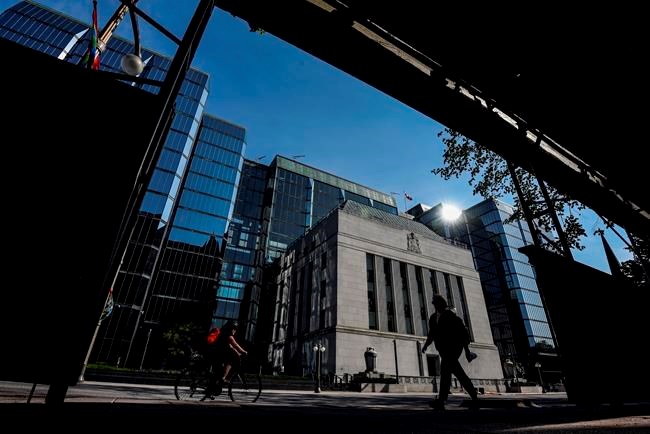Bank of Canada governor Tiff Macklem says he has no plans to cut interest rates any time soon, even as higher rates intensify risks associated with household debt and vulnerabilities in the Canadian financial system.
"Nobody should expect that interest rates are going to go back down to the very low levels that we've seen over the last decade or so," Macklem told a news conference discussing the central bank's latest financial system review Thursday.
"We're in a transition period to a world where interest rates are going to be higher than what many people have gotten used to and that transition is going to take a while. And through that transition that creates some risks."
In its annual financial system review, which highlighted the central bank's concerns around the ability of Canadian households to manage their debt amid that transition, the central bank said it is more concerned than it was a year ago about the risks posed by that debt.
While about one-third of mortgages have seen an increase in payments compared with February 2022, just prior to the Bank of Canada’s recent rate hiking campaign, nearly all borrowers are expected to face higher payments by 2026.
Mortgage payments could spike as much as 40 per cent by 2026 for those on variable-rate mortgages with fixed payments, while those with fixed-rate mortgages could see their payments increase by 20 to 25 per cent over 2022 levels.
The bank said many Canadians have less financial flexibility after stretching their budgets to get into the housing market by taking on large mortgages with lengthy amortization periods.
"A longer amortization period reduces the size of monthly payments, helping lower debt-servicing costs, but increases the period of household vulnerability because equity is built more slowly," the bank stated.
A severe global recession that causes housing prices to fall further could lead to more loan defaults, it said. As Canadian banks hold a high share of uninsured mortgages on their balance sheets, this could result in sizable credit losses if defaults were to occur on a large scale.
Carolyn Rogers, the bank's senior deputy governor, said Canadians have a long history of paying their debts even under stressed conditions and so far households are proving resilient despite the sharp increase in interest rates.
"However, in a severe and prolonged recession, mortgage defaults could rise, leading to credit losses for lenders. That in turn could lead to a further pullback in credit, worsening a downturn," Rogers said.
Meanwhile, the recent banking crises in the U.S. and Switzerland have also exposed other vulnerabilities in the current environment of higher interest rates, the Bank of Canada said in the annual report.
Although spillover effects to Canada from recent stresses in the global banking sector have been limited, the central bank said deposit runs at Silicon Valley Bank and Signature Bank in the U.S. earlier this year showed how quickly things could deteriorate.
The U.S. bank failures highlighted the need for Canadian institutions to be more vigilant as they adapt to higher interest rates, it added, noting that “the deposit runs at these institutions unfolded rapidly by historical standards, showing that social media and digital banking can accelerate such developments."
"I think as a system we are reflecting on what the lessons are," said Macklem.
"In a world of social media, in a world where banking is more digital, could deposits run off more quickly, and what does that mean for the calibration of liquidity buffers that banks need to hold?"
The central bank said if the cost of wholesale funding for Canada’s large banks were to rise significantly due to global financial stress, it could lead to Canadian institutions tightening their lending conditions.
The Bank of Canada, which increased its key interest rate from 0.25 per cent in March 2022 to 4.5 per cent this past January, said adjustments to higher interest rates could also exacerbate stresses such as fragile liquidity in fixed-income markets.
Earlier this month, Macklem said the central bank was prepared to raise rates further if signs showed inflation is likely to get stuck above its two per cent target. The bank paused its aggressive rate hiking cycle earlier this year as inflation eased to monitor the effects of its previous rate hikes on price growth.
Despite Statistics Canada reporting this week that inflation rose in April for the first time since last June, Macklem said the central bank expects the cost of living to continue on an overall downward trajectory ahead of its next monetary policy decision on June 7.
"We're determined to get inflation all the way back to the two per cent target. Inflation is coming down, we expect it will continue to come down," he said.
"We'll be looking at all the data we've received over the last six or seven weeks and we'll announce our decision."
According to the bank's annual report, financial stress is also rising among small businesses, with about one-half of firms that received government support during the pandemic reporting in a Statistics Canada survey that it would be a challenge to repay those funds by the end of this year.
The central bank added financial stability could also be threatened by a potential major cyber attack, especially in the context of geopolitical conflicts such as Russia’s invasion of Ukraine, and more frequent extreme weather events associated with climate change.
It is also monitoring the growth of cryptoassets and their connection to the financial system, but noted they do not yet pose a systemic threat due to the relatively small size of those markets compared with the broader financial sector.
This report by The Canadian Press was first published May 18, 2022.
Sammy Hudes, The Canadian Press



